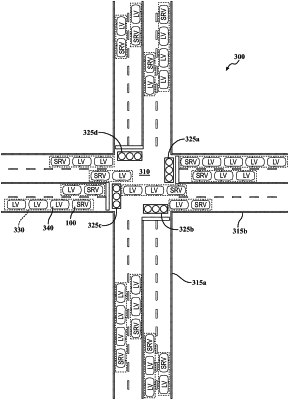| CPC G08G 1/22 (2013.01) [G05D 1/0231 (2013.01); G05D 1/0255 (2013.01); G05D 1/0257 (2013.01); G05D 1/0276 (2013.01); G05D 1/0295 (2013.01); G08G 1/162 (2013.01)] | 17 Claims |

|
1. A system for cooperatively managing mixed traffic at an intersection, the system comprising:
one or more processors in an autonomous sensor-rich vehicle; and
a memory in the autonomous sensor-rich vehicle communicably coupled to the one or more processors and storing:
a platoon formation module including instructions that when executed by the one or more processors cause the one or more processors to:
determine that one or more other vehicles are behind the autonomous sensor-rich vehicle in a same lane of traffic as the autonomous sensor-rich vehicle, the one or more other vehicles including at least one legacy vehicle, wherein the at least one legacy vehicle is without cameras, Light Detection and Ranging (LIDAR) sensors, radar sensors, and sonar sensors and includes vehicle-to-vehicle communication capability and the autonomous sensor-rich vehicle receives, from the at least one legacy vehicle, a vehicle-to-vehicle message indicating an identity and location of the at least one legacy vehicle;
communicate vehicle to vehicle from the autonomous sensor-rich vehicle with the one or more other vehicles to form a platoon that includes the autonomous sensor-rich vehicle and the one or more other vehicles; and
communicate, vehicle to vehicle, between the autonomous sensor-rich vehicle and another autonomous sensor-rich vehicle in the platoon to negotiate splitting the platoon into two platoons, a first platoon led by the autonomous sensor-rich vehicle and a second platoon led by the another autonomous sensor-rich vehicle;
an infrastructure communication module including instructions that when executed by the one or more processors cause the one or more processors to receive Signal Phase and Timing (SPaT) information from a roadside unit associated with an intersection toward which the first and second platoons are traveling; and
a maneuver-planning module including instructions that when executed by the one or more processors cause the one or more processors to:
calculate, based at least in part on the SPaT information and location information for the first platoon, a first speed profile and a first trajectory for the autonomous sensor-rich vehicle that minimize a first delay of the first platoon in traversing the intersection while also taking into account fuel consumption by the first platoon;
calculate, based at least in part on the SPaT information and location information for the second platoon, a second speed profile and a second trajectory for the another autonomous sensor-rich vehicle that minimize a second delay of the second platoon in traversing the intersection while also taking into account fuel consumption by the second platoon; and
execute the first and second speed profiles and the first and second trajectories to control indirectly the one or more other vehicles while the first and second platoons are traversing the intersection.
|